Competitive Strategy Essay: Exploring Strategy Development Tools
VerifiedAdded on 2022/12/15
|6
|1714
|412
Essay
AI Summary
This essay examines key strategy development tools essential for business management in a competitive market. It focuses on SWOT analysis, PESTLE analysis, Porter's Five Forces model, and Ansoff strategy, detailing their impact on company growth and profitability. The essay provides practical examples, including the application of SWOT to Tesco, Porter's Five Forces to British Airways, PESTLE to Sainsbury's, and Ansoff strategy to Airtel. It highlights how these tools help in assessing the marketing environment, responding to market changes, evaluating competition, and formulating growth strategies. The analysis covers both internal and external factors, demonstrating how these tools can be used to achieve positive outcomes and maintain a competitive advantage in the market. References are provided to support the analysis and findings.
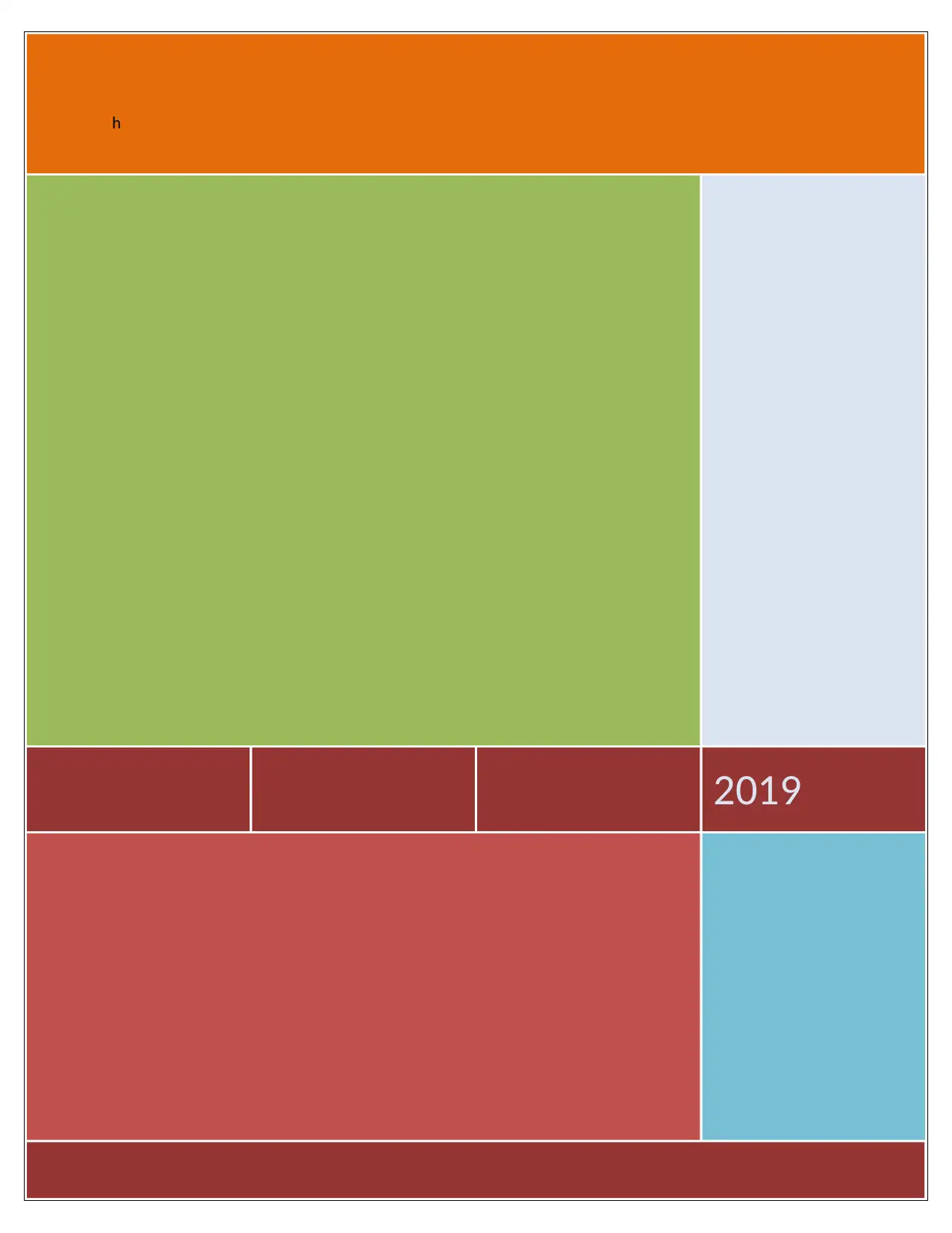
2019
h
h
Paraphrase This Document
Need a fresh take? Get an instant paraphrase of this document with our AI Paraphraser
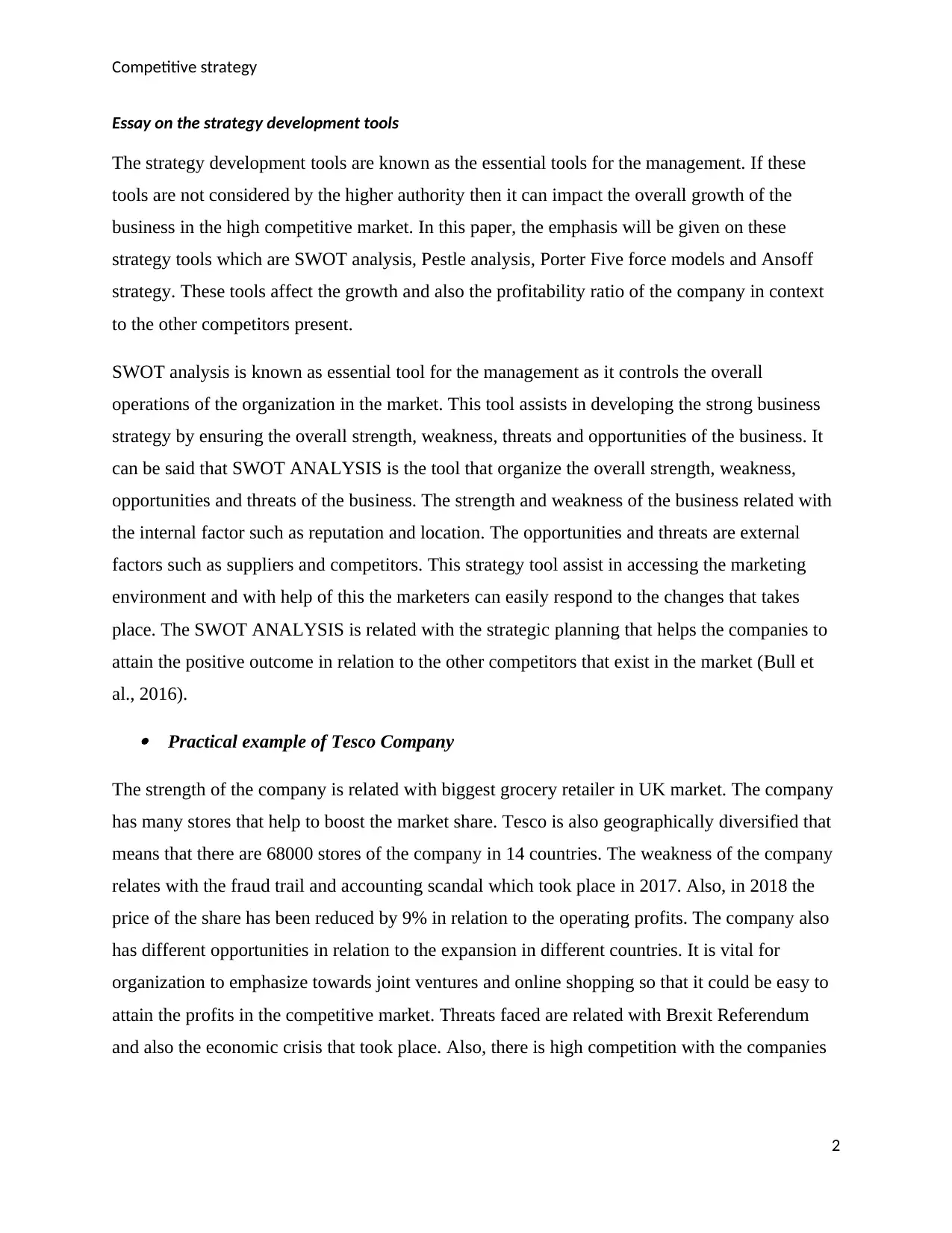
Competitive strategy
Essay on the strategy development tools
The strategy development tools are known as the essential tools for the management. If these
tools are not considered by the higher authority then it can impact the overall growth of the
business in the high competitive market. In this paper, the emphasis will be given on these
strategy tools which are SWOT analysis, Pestle analysis, Porter Five force models and Ansoff
strategy. These tools affect the growth and also the profitability ratio of the company in context
to the other competitors present.
SWOT analysis is known as essential tool for the management as it controls the overall
operations of the organization in the market. This tool assists in developing the strong business
strategy by ensuring the overall strength, weakness, threats and opportunities of the business. It
can be said that SWOT ANALYSIS is the tool that organize the overall strength, weakness,
opportunities and threats of the business. The strength and weakness of the business related with
the internal factor such as reputation and location. The opportunities and threats are external
factors such as suppliers and competitors. This strategy tool assist in accessing the marketing
environment and with help of this the marketers can easily respond to the changes that takes
place. The SWOT ANALYSIS is related with the strategic planning that helps the companies to
attain the positive outcome in relation to the other competitors that exist in the market (Bull et
al., 2016).
Practical example of Tesco Company
The strength of the company is related with biggest grocery retailer in UK market. The company
has many stores that help to boost the market share. Tesco is also geographically diversified that
means that there are 68000 stores of the company in 14 countries. The weakness of the company
relates with the fraud trail and accounting scandal which took place in 2017. Also, in 2018 the
price of the share has been reduced by 9% in relation to the operating profits. The company also
has different opportunities in relation to the expansion in different countries. It is vital for
organization to emphasize towards joint ventures and online shopping so that it could be easy to
attain the profits in the competitive market. Threats faced are related with Brexit Referendum
and also the economic crisis that took place. Also, there is high competition with the companies
2
Essay on the strategy development tools
The strategy development tools are known as the essential tools for the management. If these
tools are not considered by the higher authority then it can impact the overall growth of the
business in the high competitive market. In this paper, the emphasis will be given on these
strategy tools which are SWOT analysis, Pestle analysis, Porter Five force models and Ansoff
strategy. These tools affect the growth and also the profitability ratio of the company in context
to the other competitors present.
SWOT analysis is known as essential tool for the management as it controls the overall
operations of the organization in the market. This tool assists in developing the strong business
strategy by ensuring the overall strength, weakness, threats and opportunities of the business. It
can be said that SWOT ANALYSIS is the tool that organize the overall strength, weakness,
opportunities and threats of the business. The strength and weakness of the business related with
the internal factor such as reputation and location. The opportunities and threats are external
factors such as suppliers and competitors. This strategy tool assist in accessing the marketing
environment and with help of this the marketers can easily respond to the changes that takes
place. The SWOT ANALYSIS is related with the strategic planning that helps the companies to
attain the positive outcome in relation to the other competitors that exist in the market (Bull et
al., 2016).
Practical example of Tesco Company
The strength of the company is related with biggest grocery retailer in UK market. The company
has many stores that help to boost the market share. Tesco is also geographically diversified that
means that there are 68000 stores of the company in 14 countries. The weakness of the company
relates with the fraud trail and accounting scandal which took place in 2017. Also, in 2018 the
price of the share has been reduced by 9% in relation to the operating profits. The company also
has different opportunities in relation to the expansion in different countries. It is vital for
organization to emphasize towards joint ventures and online shopping so that it could be easy to
attain the profits in the competitive market. Threats faced are related with Brexit Referendum
and also the economic crisis that took place. Also, there is high competition with the companies
2
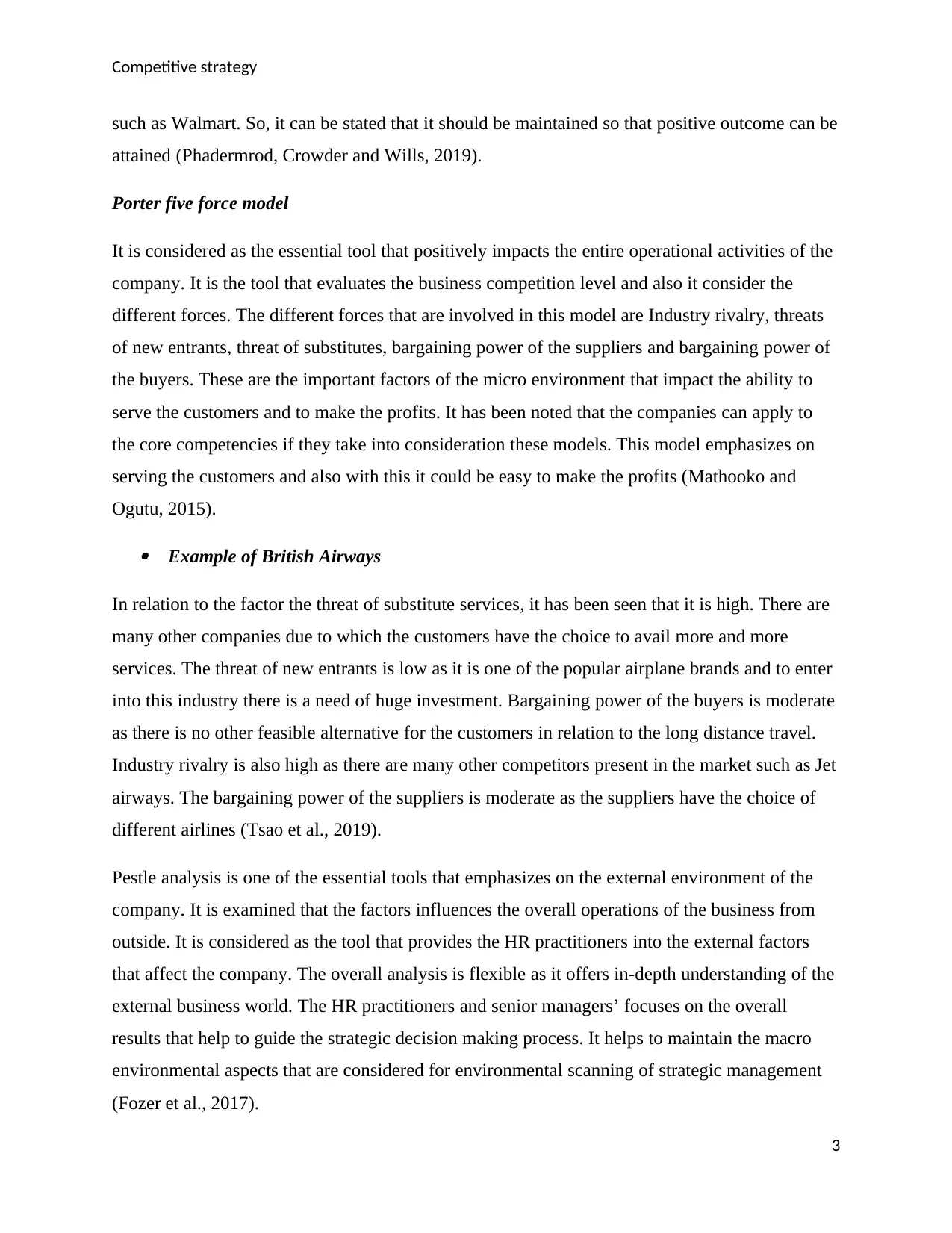
Competitive strategy
such as Walmart. So, it can be stated that it should be maintained so that positive outcome can be
attained (Phadermrod, Crowder and Wills, 2019).
Porter five force model
It is considered as the essential tool that positively impacts the entire operational activities of the
company. It is the tool that evaluates the business competition level and also it consider the
different forces. The different forces that are involved in this model are Industry rivalry, threats
of new entrants, threat of substitutes, bargaining power of the suppliers and bargaining power of
the buyers. These are the important factors of the micro environment that impact the ability to
serve the customers and to make the profits. It has been noted that the companies can apply to
the core competencies if they take into consideration these models. This model emphasizes on
serving the customers and also with this it could be easy to make the profits (Mathooko and
Ogutu, 2015).
Example of British Airways
In relation to the factor the threat of substitute services, it has been seen that it is high. There are
many other companies due to which the customers have the choice to avail more and more
services. The threat of new entrants is low as it is one of the popular airplane brands and to enter
into this industry there is a need of huge investment. Bargaining power of the buyers is moderate
as there is no other feasible alternative for the customers in relation to the long distance travel.
Industry rivalry is also high as there are many other competitors present in the market such as Jet
airways. The bargaining power of the suppliers is moderate as the suppliers have the choice of
different airlines (Tsao et al., 2019).
Pestle analysis is one of the essential tools that emphasizes on the external environment of the
company. It is examined that the factors influences the overall operations of the business from
outside. It is considered as the tool that provides the HR practitioners into the external factors
that affect the company. The overall analysis is flexible as it offers in-depth understanding of the
external business world. The HR practitioners and senior managers’ focuses on the overall
results that help to guide the strategic decision making process. It helps to maintain the macro
environmental aspects that are considered for environmental scanning of strategic management
(Fozer et al., 2017).
3
such as Walmart. So, it can be stated that it should be maintained so that positive outcome can be
attained (Phadermrod, Crowder and Wills, 2019).
Porter five force model
It is considered as the essential tool that positively impacts the entire operational activities of the
company. It is the tool that evaluates the business competition level and also it consider the
different forces. The different forces that are involved in this model are Industry rivalry, threats
of new entrants, threat of substitutes, bargaining power of the suppliers and bargaining power of
the buyers. These are the important factors of the micro environment that impact the ability to
serve the customers and to make the profits. It has been noted that the companies can apply to
the core competencies if they take into consideration these models. This model emphasizes on
serving the customers and also with this it could be easy to make the profits (Mathooko and
Ogutu, 2015).
Example of British Airways
In relation to the factor the threat of substitute services, it has been seen that it is high. There are
many other companies due to which the customers have the choice to avail more and more
services. The threat of new entrants is low as it is one of the popular airplane brands and to enter
into this industry there is a need of huge investment. Bargaining power of the buyers is moderate
as there is no other feasible alternative for the customers in relation to the long distance travel.
Industry rivalry is also high as there are many other competitors present in the market such as Jet
airways. The bargaining power of the suppliers is moderate as the suppliers have the choice of
different airlines (Tsao et al., 2019).
Pestle analysis is one of the essential tools that emphasizes on the external environment of the
company. It is examined that the factors influences the overall operations of the business from
outside. It is considered as the tool that provides the HR practitioners into the external factors
that affect the company. The overall analysis is flexible as it offers in-depth understanding of the
external business world. The HR practitioners and senior managers’ focuses on the overall
results that help to guide the strategic decision making process. It helps to maintain the macro
environmental aspects that are considered for environmental scanning of strategic management
(Fozer et al., 2017).
3
⊘ This is a preview!⊘
Do you want full access?
Subscribe today to unlock all pages.

Trusted by 1+ million students worldwide
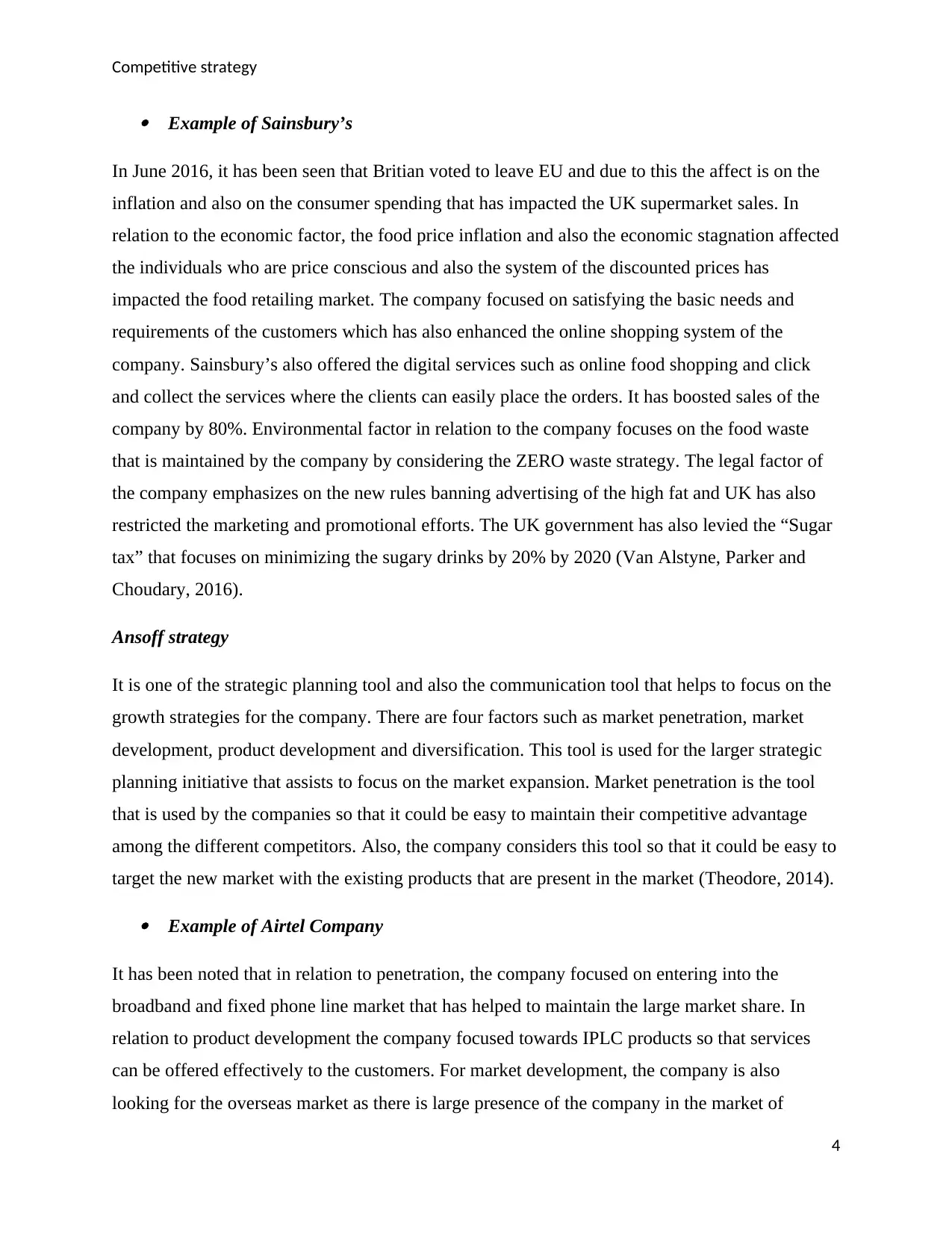
Competitive strategy
Example of Sainsbury’s
In June 2016, it has been seen that Britian voted to leave EU and due to this the affect is on the
inflation and also on the consumer spending that has impacted the UK supermarket sales. In
relation to the economic factor, the food price inflation and also the economic stagnation affected
the individuals who are price conscious and also the system of the discounted prices has
impacted the food retailing market. The company focused on satisfying the basic needs and
requirements of the customers which has also enhanced the online shopping system of the
company. Sainsbury’s also offered the digital services such as online food shopping and click
and collect the services where the clients can easily place the orders. It has boosted sales of the
company by 80%. Environmental factor in relation to the company focuses on the food waste
that is maintained by the company by considering the ZERO waste strategy. The legal factor of
the company emphasizes on the new rules banning advertising of the high fat and UK has also
restricted the marketing and promotional efforts. The UK government has also levied the “Sugar
tax” that focuses on minimizing the sugary drinks by 20% by 2020 (Van Alstyne, Parker and
Choudary, 2016).
Ansoff strategy
It is one of the strategic planning tool and also the communication tool that helps to focus on the
growth strategies for the company. There are four factors such as market penetration, market
development, product development and diversification. This tool is used for the larger strategic
planning initiative that assists to focus on the market expansion. Market penetration is the tool
that is used by the companies so that it could be easy to maintain their competitive advantage
among the different competitors. Also, the company considers this tool so that it could be easy to
target the new market with the existing products that are present in the market (Theodore, 2014).
Example of Airtel Company
It has been noted that in relation to penetration, the company focused on entering into the
broadband and fixed phone line market that has helped to maintain the large market share. In
relation to product development the company focused towards IPLC products so that services
can be offered effectively to the customers. For market development, the company is also
looking for the overseas market as there is large presence of the company in the market of
4
Example of Sainsbury’s
In June 2016, it has been seen that Britian voted to leave EU and due to this the affect is on the
inflation and also on the consumer spending that has impacted the UK supermarket sales. In
relation to the economic factor, the food price inflation and also the economic stagnation affected
the individuals who are price conscious and also the system of the discounted prices has
impacted the food retailing market. The company focused on satisfying the basic needs and
requirements of the customers which has also enhanced the online shopping system of the
company. Sainsbury’s also offered the digital services such as online food shopping and click
and collect the services where the clients can easily place the orders. It has boosted sales of the
company by 80%. Environmental factor in relation to the company focuses on the food waste
that is maintained by the company by considering the ZERO waste strategy. The legal factor of
the company emphasizes on the new rules banning advertising of the high fat and UK has also
restricted the marketing and promotional efforts. The UK government has also levied the “Sugar
tax” that focuses on minimizing the sugary drinks by 20% by 2020 (Van Alstyne, Parker and
Choudary, 2016).
Ansoff strategy
It is one of the strategic planning tool and also the communication tool that helps to focus on the
growth strategies for the company. There are four factors such as market penetration, market
development, product development and diversification. This tool is used for the larger strategic
planning initiative that assists to focus on the market expansion. Market penetration is the tool
that is used by the companies so that it could be easy to maintain their competitive advantage
among the different competitors. Also, the company considers this tool so that it could be easy to
target the new market with the existing products that are present in the market (Theodore, 2014).
Example of Airtel Company
It has been noted that in relation to penetration, the company focused on entering into the
broadband and fixed phone line market that has helped to maintain the large market share. In
relation to product development the company focused towards IPLC products so that services
can be offered effectively to the customers. For market development, the company is also
looking for the overseas market as there is large presence of the company in the market of
4
Paraphrase This Document
Need a fresh take? Get an instant paraphrase of this document with our AI Paraphraser
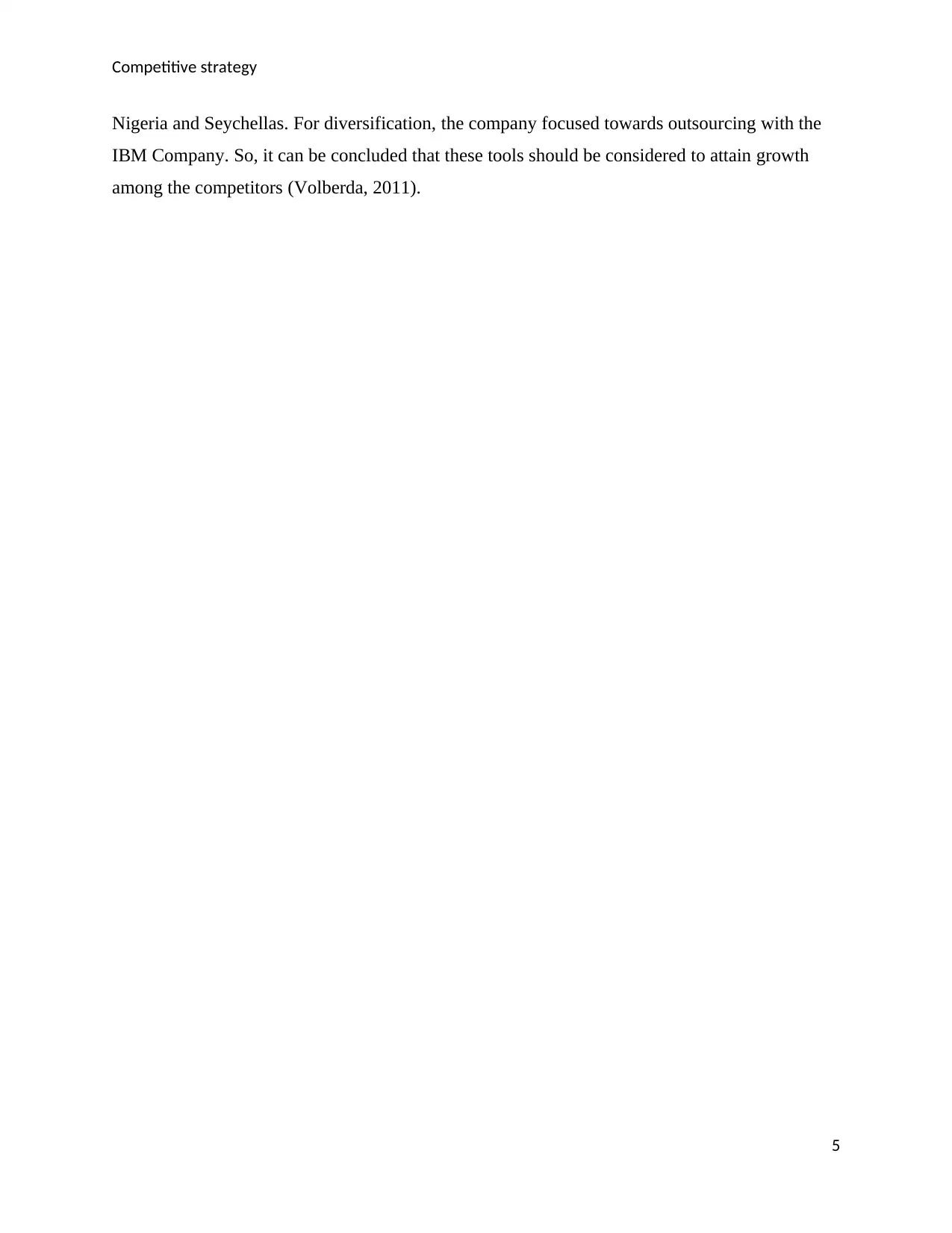
Competitive strategy
Nigeria and Seychellas. For diversification, the company focused towards outsourcing with the
IBM Company. So, it can be concluded that these tools should be considered to attain growth
among the competitors (Volberda, 2011).
5
Nigeria and Seychellas. For diversification, the company focused towards outsourcing with the
IBM Company. So, it can be concluded that these tools should be considered to attain growth
among the competitors (Volberda, 2011).
5
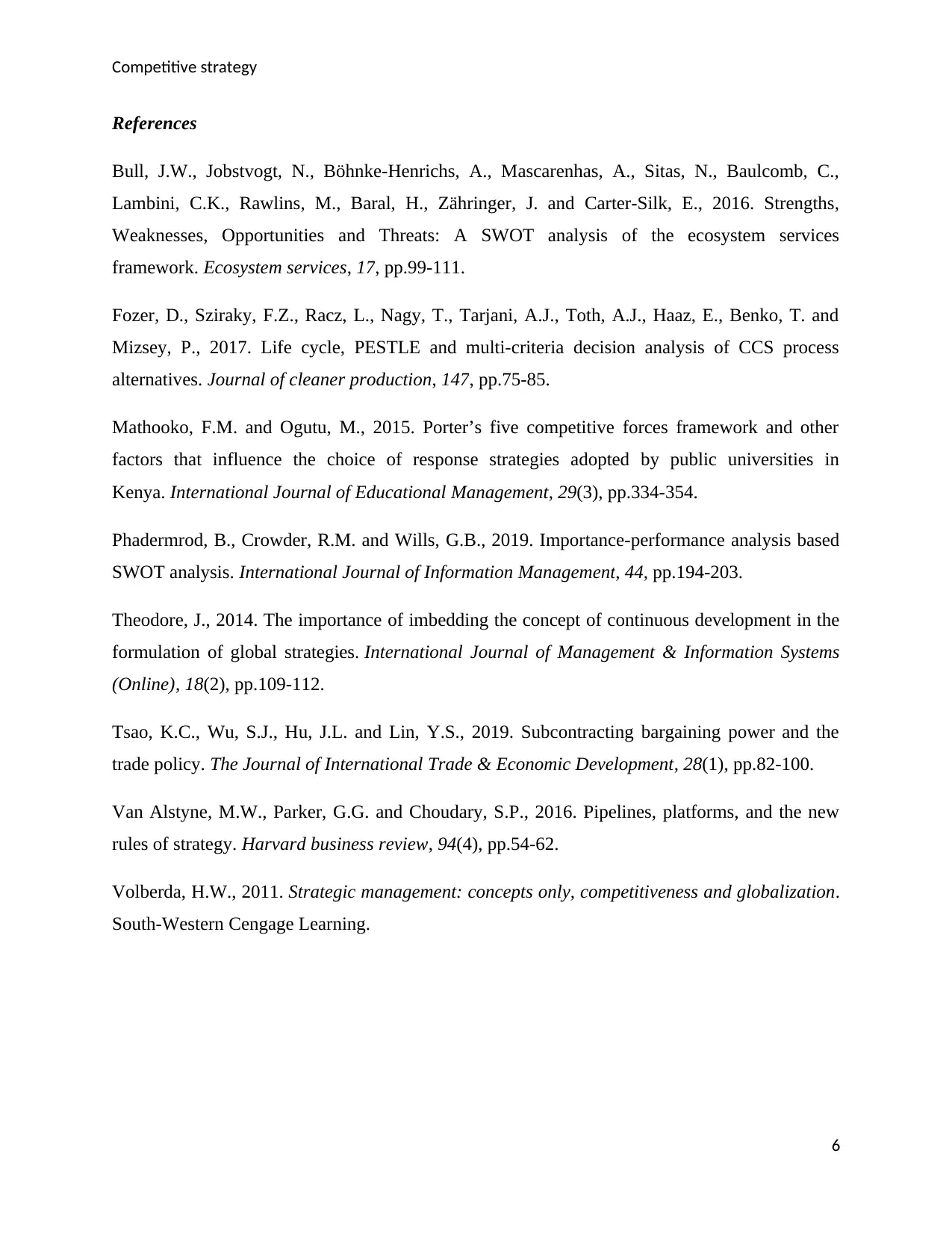
Competitive strategy
References
Bull, J.W., Jobstvogt, N., Böhnke-Henrichs, A., Mascarenhas, A., Sitas, N., Baulcomb, C.,
Lambini, C.K., Rawlins, M., Baral, H., Zähringer, J. and Carter-Silk, E., 2016. Strengths,
Weaknesses, Opportunities and Threats: A SWOT analysis of the ecosystem services
framework. Ecosystem services, 17, pp.99-111.
Fozer, D., Sziraky, F.Z., Racz, L., Nagy, T., Tarjani, A.J., Toth, A.J., Haaz, E., Benko, T. and
Mizsey, P., 2017. Life cycle, PESTLE and multi-criteria decision analysis of CCS process
alternatives. Journal of cleaner production, 147, pp.75-85.
Mathooko, F.M. and Ogutu, M., 2015. Porter’s five competitive forces framework and other
factors that influence the choice of response strategies adopted by public universities in
Kenya. International Journal of Educational Management, 29(3), pp.334-354.
Phadermrod, B., Crowder, R.M. and Wills, G.B., 2019. Importance-performance analysis based
SWOT analysis. International Journal of Information Management, 44, pp.194-203.
Theodore, J., 2014. The importance of imbedding the concept of continuous development in the
formulation of global strategies. International Journal of Management & Information Systems
(Online), 18(2), pp.109-112.
Tsao, K.C., Wu, S.J., Hu, J.L. and Lin, Y.S., 2019. Subcontracting bargaining power and the
trade policy. The Journal of International Trade & Economic Development, 28(1), pp.82-100.
Van Alstyne, M.W., Parker, G.G. and Choudary, S.P., 2016. Pipelines, platforms, and the new
rules of strategy. Harvard business review, 94(4), pp.54-62.
Volberda, H.W., 2011. Strategic management: concepts only, competitiveness and globalization.
South-Western Cengage Learning.
6
References
Bull, J.W., Jobstvogt, N., Böhnke-Henrichs, A., Mascarenhas, A., Sitas, N., Baulcomb, C.,
Lambini, C.K., Rawlins, M., Baral, H., Zähringer, J. and Carter-Silk, E., 2016. Strengths,
Weaknesses, Opportunities and Threats: A SWOT analysis of the ecosystem services
framework. Ecosystem services, 17, pp.99-111.
Fozer, D., Sziraky, F.Z., Racz, L., Nagy, T., Tarjani, A.J., Toth, A.J., Haaz, E., Benko, T. and
Mizsey, P., 2017. Life cycle, PESTLE and multi-criteria decision analysis of CCS process
alternatives. Journal of cleaner production, 147, pp.75-85.
Mathooko, F.M. and Ogutu, M., 2015. Porter’s five competitive forces framework and other
factors that influence the choice of response strategies adopted by public universities in
Kenya. International Journal of Educational Management, 29(3), pp.334-354.
Phadermrod, B., Crowder, R.M. and Wills, G.B., 2019. Importance-performance analysis based
SWOT analysis. International Journal of Information Management, 44, pp.194-203.
Theodore, J., 2014. The importance of imbedding the concept of continuous development in the
formulation of global strategies. International Journal of Management & Information Systems
(Online), 18(2), pp.109-112.
Tsao, K.C., Wu, S.J., Hu, J.L. and Lin, Y.S., 2019. Subcontracting bargaining power and the
trade policy. The Journal of International Trade & Economic Development, 28(1), pp.82-100.
Van Alstyne, M.W., Parker, G.G. and Choudary, S.P., 2016. Pipelines, platforms, and the new
rules of strategy. Harvard business review, 94(4), pp.54-62.
Volberda, H.W., 2011. Strategic management: concepts only, competitiveness and globalization.
South-Western Cengage Learning.
6
⊘ This is a preview!⊘
Do you want full access?
Subscribe today to unlock all pages.

Trusted by 1+ million students worldwide
1 out of 6
Related Documents
Your All-in-One AI-Powered Toolkit for Academic Success.
+13062052269
info@desklib.com
Available 24*7 on WhatsApp / Email
![[object Object]](/_next/static/media/star-bottom.7253800d.svg)
Unlock your academic potential
Copyright © 2020–2025 A2Z Services. All Rights Reserved. Developed and managed by ZUCOL.





